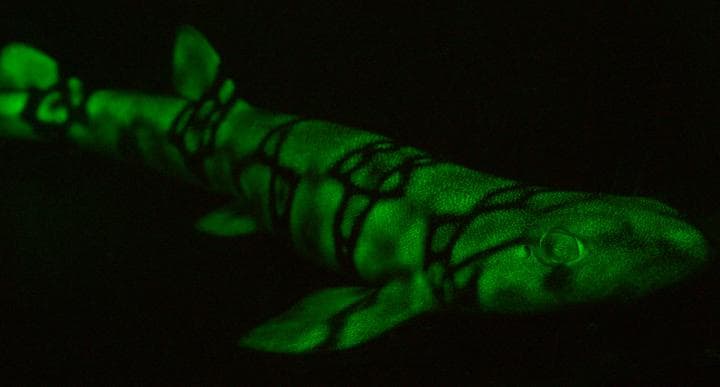Patterns On Biofluorescent Sharks Get Brighter With Depth
Catsharks taxonomically belong to one of the largest families, Scyliorhinidae and possess a unique pair of cat-like eyes and body-patterns, where some of them are commonly dubbed as Chain Catsharks. They illuminate their patches with the help of biofluoresence. Recently, a group of scientists from the American Museum of Natural History has discovered the beauty of mathematics inside their bright patterns. According to the team’s report, catsharks can not only see their glowing patterns, but these patterns are sensitive to the depth of water.
Scientists relied on computer simulations that had taken data from a customized "shark-eye" camera tool. Results revealed that the glowing patterns are visible to neighbouring catsharks and work as a communication medium among them. John Sparks, a curator in the American Museum of Natural History's Department of Ichthyology and one of the contributors to the project has tagged the work as a pioneering step to create a link between visual capabilities and emitted fluorescence which also defines the functionality of glowing patterns.

Biofluoroscent Chain Catshark
Sparks, being one of the co-authors realized that the working process of biofluorosense, where some organisms absorb light from nature, transform it and emit as a different color. In the last few years, scientists have approved that fish living inside water-bodies live in a blue environment, where the color fades with growing depth. Modern theory asserts that some fish absorb the blue lights and re-emit it in different variants such as dark neon green and orange.
The objective of their study was to unearth the mystery behind these emitted lights. During the later stage, the group has taken two sample spaces comprising chain catsharks (Scyliorhinus retifer) and swellsharks (Cephaloscyllium ventriosum). Owing to microspectrophotometry, the group realized that the catsharks’ eyes are sensitive to low-light and use the information to process a special camera filter that mimics how a light is incident on a catshark's eyes.
Sparks and his colleagues have conducted different experiments at Scripps Canyon in San Diego County which has concluded that some shark eyes are 100 times more sensitive than humans in low-light conditions. Being habituated to prevail in dim-light, the mathematical model corresponding to the research data has also implied that the contrast of fluorescence increases with depth. The research report was published in the 25 April issue of the Scientific Reports journal.
Source: #-Link-Snipped-#
Scientists relied on computer simulations that had taken data from a customized "shark-eye" camera tool. Results revealed that the glowing patterns are visible to neighbouring catsharks and work as a communication medium among them. John Sparks, a curator in the American Museum of Natural History's Department of Ichthyology and one of the contributors to the project has tagged the work as a pioneering step to create a link between visual capabilities and emitted fluorescence which also defines the functionality of glowing patterns.

Biofluoroscent Chain Catshark
The objective of their study was to unearth the mystery behind these emitted lights. During the later stage, the group has taken two sample spaces comprising chain catsharks (Scyliorhinus retifer) and swellsharks (Cephaloscyllium ventriosum). Owing to microspectrophotometry, the group realized that the catsharks’ eyes are sensitive to low-light and use the information to process a special camera filter that mimics how a light is incident on a catshark's eyes.
Sparks and his colleagues have conducted different experiments at Scripps Canyon in San Diego County which has concluded that some shark eyes are 100 times more sensitive than humans in low-light conditions. Being habituated to prevail in dim-light, the mathematical model corresponding to the research data has also implied that the contrast of fluorescence increases with depth. The research report was published in the 25 April issue of the Scientific Reports journal.
Source: #-Link-Snipped-#
Replies
You are reading an archived discussion.
Related Posts
Looking for a large-aperture lens, vast zoom range an efficient image sensor in your camera? Sony's new Cyber-Shot series RX10 III might just be the right device for you. Featuring...
After graduating as a computer science engineer in the year 2006, Amar Gautam started working as a software engineer at KPIT, Pune. Within 4 years he became a Technical Leader...
Motorola finally launched the much awaited Moto 360 Sport in India for a price tag of ₹19,999 through FlipKart. This smartwatch is a sports variant of the recently launched generation...
Today, anyone with an internet connection was scrambling to get a website to open on their browsers. The website in question was docoss[dot]com. The media was quick to spread the...
The smartphone which was launched in China back in December 2015, has finally been unveiled for Indian markets at Rs.26,999. The official launch is slated to be on Thursday. The...
